Greenhouse Insect Management
ENT-60: Greenhouse Insect Management | Download PDF
by Ric Bessin, Lee H. Townsend, Extension Entomologists & Robert G. Anderson, Extension Horticulturist
University of Kentucky College of Agriculture
The warm, humid conditions and abundant food in a greenhouse provide an excellent, stable environment for pest development. Often, the natural enemies that serve to keep pests under control outside are not present in the greenhouse. For these reasons, pest situations often develop in this indoor environment more rapidly and with greater severity than outdoors. Pest problems can be chronic unless recognized and corrected.
Successful control of insect pests on greenhouse vegetables and ornamentals depends on several factors. Proper cultural practices can minimize the chance for initiation and buildup of infestations. Early detection and diagnosis are keys to greenhouse pest management, as well as the proper choice and application of pesticides when they are needed. The pests that attack plants produced under conventional greenhouse practices also infest plants produced in float systems. Float systems are especially prone to problems with fungus gnats, shore flies and bloodworms.
Some greenhouse insects can transmit diseases to the plants which are often more serious than the feeding injury that the insect causes. These insect “vectors” include some aphids, leafhoppers, thrips and whiteflies. In these instances, the diseases must be managed through early insect control.
Greenhouse Pesticide Safety
While pesticides are important tools used in managing greenhouse pests, their use in enclosed spaces increases the potential for worker exposure during and after application. PAT-4, Greenhouse Pesticides and Pesticide Safety, contains information on general precautions needed when using pesticides in the greenhouse, appropriate safety equipment, calibration and application, as well as specific information on pesticides registered for greenhouse use. PAT-4 is available at your county Cooperative Extension Service office.
Common Greenhouse Insects and Related Pests
Since greenhouse conditions allow rapid development of pest populations, early detection and diagnosis of pest insects are necessary to make control decisions before the problem gets out of hand and you suffer economic loss. Some common and important greenhouse pests to keep a close watch for are aphids, fungus gnats, thrips, whiteflies, caterpillars, leafminers, mealybugs, mites, slugs and snails.
Aphids
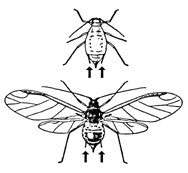 Aphid Cornicles
Aphid Cornicles
Aphids or plant lice are small, soft-bodied, sluggish insects that cluster in colonies on the leaves and stems of the host plants. They are sucking insects that insert their beaks into a leaf or stem to extract plant sap. They are usually found on and under the youngest leaves, and, in general, prefer to feed on tender, young growth.
Aphids are the only insects that have a pair of cornicles, or tubes that resemble exhaust pipes, on their abdomen.
Aphids multiply rapidly. In greenhouses, each one is a female capable of giving live birth to daughters in about seven days after its own birth. These asexually reproducing female aphids may be winged or wingless. Adult aphids can give birth to six to ten young per day over their 20- to 30-day life span. Enormous populations can build up in a relatively short period.
Feeding by aphids can cause leaves or stems to curl or pucker; this leaf distortion often protects the aphids from contact insecticides. Much of the sap they suck from the plant passes through their bodies and is dropped on the leaves as “honeydew.” Ants, which feed on honeydew, are often found in association with aphid infestations. Black sooty mold often develops on leaves with honeydew.
Aphids can also transmit serious viral diseases. Managing these diseases usually requires control of the insect that transmits the disease. Aphid infestations usually begin with winged individuals entering the greenhouse through openings.
Insecticide applications to control aphids often must be repeated to manage infestations. Usually two to three applications spaced at three- to seven-day intervals, depending on the severity of an infestation, are necessary. Insecticide products need to be alternated for aphid control to delay development of resistance.
If you observe aphids that appear tan or off-color relative to the other aphids, they may be parasitized aphids known as “mummies.” These naturally-occurring wasp parasites so important to aphid control are smaller than aphids. When these parasites emerge, they cut a round hole in the upper portion of the abdomen of the dead aphid and begin to search for their prey.
Fungus Gnats, Shore Flies and Bloodworms
The high humidity and moist organic growing media in greenhouses provide an excellent breeding area for several types of gnats. These insects are abundant outdoors where they can breed in virtually any accumulation of standing water that remains in place for several days.
 Fungus Gnat Adult and Larva
Fungus Gnat Adult and Larva
Fungus Gnats
Fungus gnat larvae can be serious pests of some greenhouse plants. The larvae of most species are scavengers, feeding on decaying organic matter in the soil. However, larvae of some species will feed on root hairs, enter the roots or even attack the crown or stem of the plant. Plants infested with fungus gnats generally lack vigor and may begin to wilt. Adults are frequently observed running on the foliage or medium before injury caused by the larvae becomes apparent.
Fungus gnats are small (1/8 inch) black flies with comparatively long legs and antennae, tiny heads and one pair of clear wings. Females lay tiny ribbons of yellowish-white eggs in growing media that hatch within four days. The clear larvae are legless and have black heads.
Larvae mature underground in about 14 days and pupate near the surface of the medium. They construct a pupal case made of soil debris. Adults live only about a week. Under greenhouse conditions, about 20-25 days are required to complete a generation. Larvae are somewhat gregarious and are found in clusters in the soil.
 Shore Fly
Shore Fly
Shore Flies
Shore flies are gnat-like insects similar to fungus gnats. They differ in having short antennae, red eyes and heavier dark bodies. A pair of smoky wings with several clear spots can be seen when looking closely at the insect. They are good fliers and can be seen resting on almost any surface in the greenhouse. They resemble winged aphids, but aphids have two pairs of wings and the distinctive, tube-like cornicles on the abdomen.
Their life cycle is similar to that of the fungus gnat. The yellow to brown larvae, which may be up to 1/4-inch long, differ in having no apparent head. Both larvae and adults feed mostly on algae growing on media, floors, benches or pots. They rarely damage plant tissue, but the mobile adults may spread soil pathogens inside the greenhouse.
Bloodworms
Bloodworms are the striking red “worms” that may be seen wriggling in float plant water. These long, cylindrical larvae are similar to fungus gnat larvae in lacking legs and having a distinct brown head. The red is due to the presence of hemoglobin, the same oxygen-carrying material present in human blood. The presence of hemoglobin allows this insect to develop in water with a very low oxygen content.
 Bloodworm
Bloodworm
Bloodworms are common in stagnant water, animal watering troughs and other accumulations of standing water. These insects are close relatives of the mosquito, but the adults do not have sucking mouthparts and are not blood feeders. The larvae have chewing mouthparts and generally feed on algae or other organic matter in the water. They may be found in plant roots that grow through the bottoms of float trays but apparently do not cause significant injury.
While fungus gnats and shore flies live in “very wet” situations, bloodworms generally live entirely in water. Eliminating standing puddles around the area and keeping to a minimum the amount of exposed water surface in the float bed will reduce the presence of these insects.
Avoiding excessive watering to reduce moisture in growing media will help regulate these pests because they require high moisture. Highly organic soils and potting mixtures containing peat are attractive to egg-laying fungus gnats. Sprays or drenches containing Bacillius thuringiensis Serotype H-14 (Gnatrol) can be used to control fungus gnat larvae on ornamentals and nursery plantings in the greenhouse. This treatment is not effective against shore flies.
Thrips
Thrips are tiny, slender insects about 1/25-inch long. They range in color from light brown to black. They have four wings, each fringed with a row of long hairs, that are held flat over their back. Plant-feeding thrips cause economic damage when they infest the flowers, buds and young fruits of a crop.
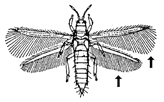 Thrips
Thrips
Thrips feed by rasping the plant surface and sucking up the exuding sap. Heavily infested leaves have a mottled or silvery appearance. Female thrips insert eggs into slits in the leaf. Eggs hatch in two to seven days. Nymphs feed much like adults and molt four times during development. They are inactive during the last nymphal stage before becoming an adult.
Winged adults are carried into the greenhouse on contaminated plant material, or they fly in during the summer and continue to breed throughout the winter. Preventing infestations through the use of screens on ventilators, inspecting new material entering the greenhouse and controlling weeds in the greenhouse will help to manage thrips.
Several species occur in greenhouses. Thrips attack a wide range of plants in the greenhouse. Highly susceptible hosts include azalea, calla lily, croton, cyclamen, cucumber, fuchsia, ivy and rose. Various thrip species also transmit plant diseases. The most serious are the western flower thrips and onion thrips, which are vectors of tomato spotted wilt virus or impatiens necrotic spot virus. This virus attacks a wide variety of plants.
Greenhouse and Sweet Potato Whiteflies
Whiteflies are serious pests in the greenhouse and are often seen on fuchsias, poinsettias, cucumbers, lettuce and tomatoes. Through regular monitoring, these preferred hosts can be used as indicator “plants,” alerting greenhouse managers to the first signs of whitefly infestations. These powdery white insects, about 1/12 inch in length, flutter from the undersides of leaves when the plants are disturbed. The lower surface of the leaves may be infested with all life stages of whiteflies.
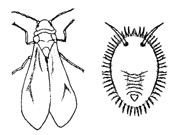 Whitefly and Larva
Whitefly and Larva
The female of these sap-sucking insects may lay 150 eggs at the rate of 25 per day. The newly emerged crawler moves only a short distance before settling down to feed. After three larval molts, the pupal stage is formed, from which the adult emerges. The entire life cycle takes 21-36 days, depending on the greenhouse environment.
The greenhouse and sweet potato whiteflies are similar in appearance but differ in their biology and control. Both whitefly species develop entirely on the undersides of leaves. Their life cycle may be as short as 20 to 25 days.
The sweet potato whitefly has a broader host range, higher reproductive potential, stronger resistance to insecticides and a powerfully phytotoxic enzyme system. This whitefly is a vector of gemini viruses in tomatoes. Control of these viruses relies on proper sanitation and control of the whitefly vectors.
Insecticides used to control adult whiteflies are usually ineffective against immatures. Because adult whiteflies often continue to emerge after these applications, insecticides used to control adults must be applied frequently, two to three times with three- to four-day intervals between sprays, to control infestations. Growth regulators used to control immature stages can be applied less frequently, at seven- to 14-day intervals as necessary, to control infestations.
A tiny parasitic wasp, Encarsia formosa, attacks the larval stage of whiteflies and sometimes occurs naturally in greenhouses. While they are not useful in controlling heavy whitefly infestations, they can be used successfully against early infestations under conditions that favor their development over the development of whiteflies (64°- 80°F).
After the parasitized larvae die and turn black, a parasite wasp will emerge and continue the beneficial process. Do not throw pruned leaves away without checking them for black larvae containing parasites. Leave these under plants for about one week until wasps have emerged.
This beneficial insect is very susceptible to insecticides. It is more effective in controlling greenhouse whitefly than sweet potato whitefly. It can be purchased commercially and introduced at intervals when whiteflies are first observed. See ENTFact-125, Vendors of Beneficial Organisms in North America, for more information.
Cutworms, Armyworms, Loopers and Other Caterpillars
All caterpillars are the immature stages of moths. They chew on leaves, stems and fruits of many kinds of plants. Infestations may begin when moths enter through ventilators or when infested plants are brought into the greenhouse. Cutworms can be serious pests of younger plants. They hide during the day in soil or mulch and feed on the plants at night.

Cutworm larva (left) and Cabbage looper (right)
The cabbage looper can be a pest of greenhouse crops, especially lettuce. It can be distinguished by its pale green color, three pairs of prolegs (small fleshy bumps on the underside of the abdomen) and looping movement (bringing the rear of its body up to the front legs before moving the front legs forward) similar to that of measuringworms. When monitoring for these insects, look for cut plants or leaves with large sections removed. Sprays containing Bacillius thuringiensis are effective against these pests.
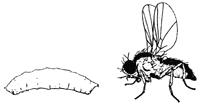 Leafminer Fly and Larva
Leafminer Fly and Larva
Leafminers
Leafminers are larvae of small flies. They damage plants by feeding between the upper and lower surface of the leaf. Damaged areas are light in color and narrow and winding. They increase in width as the larva grows. When fully grown, the larva may pupate in the leaf tissue or emerge from the leaf and fall to the gound to pupate. Each female fly will lay from 50 to 100 eggs by inserting them into pits made in the leaf surface. Because the damaging stages of the insects occur entirely inside the leaf, control with contact insecticides is ineffective once the damage appears. Infestations can be avoided through the use of good cultural practices, hand removal and disposal of infested leaves and use of chemical controls when necessary.
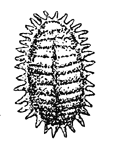 Mealybug
Mealybug
Mealybugs
Mealy bugs are small, soft-bodied insects which, like aphids, feed on plant sap. These insects are thickly covered with mealy or waxy secretions which provide some protection from contact insecticides. Some species lay eggs; others give birth to live young. Like aphids, mealybugs often produce large amounts of honeydew that results in sooty mold on leaves and other plant parts.
Mealybugs may infest almost any part of the plant. A wide variety of plants in the greenhouse are susceptible to mealybugs, but they are often seen first on crotons, hoyas and bamboo palms. Ants, which collect honeydew as food, are often seen in association with mealybug infestations.
Mites
Mites are sap-sucking pests which attack a wide range of greenhouse plants. Two species, the two-spotted spider mite and the cyclamen mite, can cause serious and persistent problems. These mites feed by piercing tissue with their mouthparts and sucking out cell contents.
 Two-spotted Spider Mite
Two-spotted Spider Mite
Two-spotted spider mites are light to dark green with two distinctive black spots on the abdomen. Eggs are spherical and clear when first laid. After hatching, the larva has three pairs of legs, but later stages will have four pairs. Males are smaller with more pointed abdomens than females. Heavy infestations of the two-spotted spider mite produce fine webbing which may cover the entire plant.
Generally they feed on the undersides of leaves, giving the upper leaf surface a speckled or mottled appearance. Leaves of mite-infested plants may turn yellow and dry up, and plants may lose vigor and die when infestations are severe. Females can lay 200 eggs, and during hot, dry weather the life cycle may be completed in seven days. Marigolds, crotons, chrysanthemums, roses, impatiens, parlor palms, bamboo palms and ivy geraniums are highly susceptible to two-spotted spider mites and can be used as indicator plants to alert managers to infestations.
Cyclamen mites are minute, elliptical, semi-transparent, greenish mites. These mites thrive when the temperature is around 60°F and can complete their life cycle in about two weeks. African violets, cyclamen, dahlia, gloxinia and New Guinea impatiens are highly susceptible to cyclamen mites and can be used as indicator plants to alert greenhouse managers.
Depending on the type of plant attacked, cyclamen mites may infest the entire plant or be concentrated around the buds. Infested leaves become distorted and often curl inward; foliage may become darker than that of healthy leaves. Because of their small size, infestations often go undetected until the damage is severe. Usually it is the nature of the injury, not the mites themselves, that alerts greenhouse managers to cyclamen mite infestations.
Mites can easily be moved to infested plants on clothing, so always examine infested benches and other hot spots last during greenhouse inspections. Often, it is better to discard infested plants than to attempt to control the problem with pesticides. If control is attempted, isolate the infested plants to reduce potential spread.
Resistance to pesticides has increased the difficulty of controlling these pests. Because mites primarily occur on the undersides of leaves, applications of contact miticides should be directed at both the lower and upper leaf surfaces. Mite eggs are resistant to some insecticides, so repeated applications are often necessary to control infestations. Two to three applications spaced five days apart may be necessary. Miticides with different modes of action need to be alternated, so different products are used to control each subsequent mite generation.
Several species of mite predators are commercially available. These are usually released when mites first appear and should be evenly dispersed throughout the greenhouse. If mite infestations are heavy, consider spraying with an insecticidal soap before releasing predator mites. Selection of the proper predatory mite species will depend on greenhouse temperatures and humidity. If predatory mites are used, early release at the first sign of mite infestation is critical. Unlike a miticide, predatory mites will take some time to control infestations. See ENTFact-125, Vendors of Beneficial Organisms in North America, for a list of predatory mites and suppliers.
Slugs and Snails
Slugs and snails can become greenhouse pests when the humidity is high. Slugs are fleshy, slimy animals that feed mainly at night. They prefer cool, moist hiding places during the day. Slugs rasp on leaves, stems, flowers and roots. They produce holes in the leaves or just scar the leaf surface. Small seedlings are especially vulnerable to these creatures. Silvery slime trails are evidence of snail and slug infestations.
Sanitation is important for slug control. Keep the greenhouse free of plant debris (leaves, pulled weeds, etc.), old boards, bricks or stones that provide cool, moist hiding places for slugs. Barriers of diatomaceous earth, lime, sawdust, copper stripping and salt-embedded plastic strips can be used around benches. Metaldehyde or mesurol bait pellets can be distributed beneath the benches in greenhouses for slug and snail control on ornamentals. Do not allow pellets to come in contact with plants.
General Strategies for Insect and Mite Management
Cultural Controls are Essential
Pests are generally brought into the greenhouse on new plant material. Others may enter the greenhouse in the summer when the ventilators are open. Many are able to survive short periods of time between harvest or plant removal and production of the next crop. Cultural controls are the primary defense against insect infestations.
The following cultural practices will help to prevent pest infestations:
- Inspect new plants thoroughly to prevent the accidental introduction of pests into the greenhouse.
- Keep doors, screens and ventilators in good repair.
- Use clean or sterile soils or ground media. Clean or sterilize tools, flats and other equipment.
- Maintain a clean, closely mowed area around the greenhouse to reduce invasion by pests that develop in weeds outdoors.
- Eliminate pools of standing water on floors. Algal and moss growth in these areas can be sources of fungus gnat and shore fly problems.
- Dispose of trash, boards and old plant debris in the area.
- Remove all plants and any plant debris, clean the greenhouse thoroughly after each production cycle.
- If possible, allow the greenhouse to freeze in winter to eliminate tender insects like whiteflies.
- Avoid overwatering and promote good ventilation to minimize wet areas conducive to fly breeding.
- Avoid wearing yellow clothing which is attractive to many insect pests.
- Maintain a weed-free greenhouse at all times.
- Eliminate infestations by discarding or removing heavily infested plants.
Monitoring
Early detection and diagnosis of pest infestations will allow you to make pest control decisions before the problem gets out of hand. It is good practice to make weekly inspections of plants in all sections of the greenhouse. When monitoring, select plants so that they represent the different species in the greenhouse. Pay particular attention to plants near ventilators, doors and fans. At least 1% of the plants need to be examined on each monitoring visit in the greenhouse.
Insect monitoring devices should be used in the greenhouse. Yellow sticky cards (PT Insect Monitoring & Trapping System, Whitmire, St. Louis, MO) are highly attractive to winged aphids, leafminer adults, whiteflies, leafhoppers, thrips (blue cards can also be used with thrips), various flies and other insects. White sticky cards can be used to detect fungus gnat adults. These can be used to alert you to the presence of a pest and identify hot spots in the greenhouse. One to three cards per 1000 square feet in the greenhouse is recommended. Cards should be changed weekly. Typically, these sticky cards are suspended vertically just above the tops of the plants. They can be attached to sticks or hung on string. If you cannot identify a trapped insect, contact your county Extension agent for assistance.
Mass trapping products such as sticky tapes are also available for management of thrips, whiteflies, leafminers and fungus gnats. While sticky cards are primarily used just to alert you to insect infestations, mass trapping tools are used to reduce and manage insect infestations. Mass trapping relies on using enough surface area of the attractive sticky tapes to capture and reduce pest numbers. Care should be taken to keep monitoring and trapping products dry and free of debris. This will maintain effectiveness of the traps.
Biological Control Agents
Natural enemies are commercially available for control of some greenhouse pests. For a listing of sources, see ENT-53, Vendors of Beneficial Organisms in North America.
Levels of pest control obtained with beneficial organisms will vary greatly depending on a number of factors, including:
- species of pest involved
- species of natural enemy used
- timing of release of natural enemy relative to pest buildup and crop development
- numbers of beneficials released
- greenhouse temperature and range of fluctuation
- time of year
- condition of the beneficials at release
- pesticide usage before and after release of beneficials.
Biological control generally requires more time than pesticides to bring a pest population under control. Natural enemies require time to disperse from release sites and to search for prey or hosts. Appropriate natural enemies should be released as soon as the pest is detected in the greenhouse.
Natural enemies do not provide sufficiently rapid control of pests that are already causing serious losses, and they will not generally eradicate an infestation. In some instances, using an insecticidal soap or other non-residual insecticide is recommended to reduce the infestation before releasing the natural enemies. Knowledge of pest biology and monitoring of pest populations are critical to determining when to make releases.
Greenhouse managers should avoid unnecessary insecticide/miticide applications before and after release of natural enemies. If insecticide/miticide treatments are required, limit treatments to pest “hot spots” to avoid treating the entire greenhouse. Use a selective, short residual pesticide if possible. For example, Bacillius thuringiensis (Bt) products can be used to control caterpillars without harm to natural enemies in the greenhouse.

Pesticide Management
Greenhouse operators need to maximize the effectiveness of insecticides and miticides. To provide adequate control, a pesticide must be applied at the proper rate, when the pest is present. Coverage and sufficient pressure are needed to penetrate dense foliage and reach the target pest. This is especially important for sucking insects that infest the lower surface of leaves. Older, lower leaves can be removed to open the canopy of some crops to increase spray coverage. Insecticide or miticide applications must sometimes be repeated frequently to maintain a pest at acceptable levels.
Timing of pesticide applications is important. Some pests are vulnerable to pesticides only at certain stages in their life cycle. For whitefly management, begin control measures early. If control action is delayed until an abundance of adult whiteflies can be seen, then numerous eggs and immature stages, which are more difficult to control, are usually present.
With a limited number of pesticides available for greenhouse use, it is always a concern that pests may develop resistance to pesticides. Managers should rotate among different pesticides for successive applications when controlling specific pests. Rotations must include pesticides belonging to different chemical classes that use different modes of action to control the pests. This will prevent, or at least delay, the development of resistance to a particular pesticide.
To aid pesticide applications, plants that are frequently infested by the same pest and can be legally sprayed with the same material should be grouped together. This will reduce the potential for misapplications to unlabelled crops. Additionally, moving infested material through the greenhouse can spread an infestation to other areas.
Revised: 4/07
CAUTION! Pesticide recommendations in this publication are registered for use in Kentucky, USA ONLY! The use of some products may not be legal in your state or country. Please check with your local county agent or regulatory official before using any pesticide mentioned in this publication.
Of course, ALWAYS READ AND FOLLOW LABEL DIRECTIONS FOR SAFE USE OF ANY PESTICIDE!
Images: University of Kentucky Entomology
